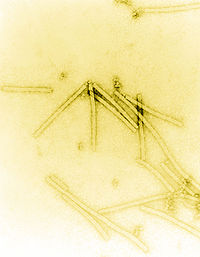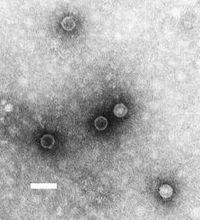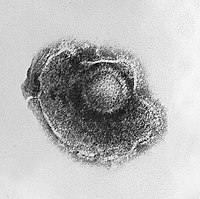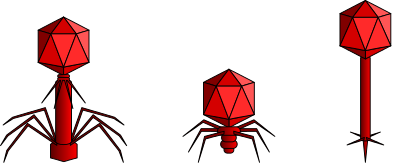Difference between revisions of "AY Honors/Viruses/Answer Key"
JadeDragon (talk | contribs) (prions) |
JadeDragon (talk | contribs) (diseases, difficulty of treating. last section is partly quoting a U.S. Department of Health and Human Services publication, rest sourced from wikipedia and reworked) |
||
| Line 81: | Line 81: | ||
===f. Have viral diseases ever been eradicated? Why is it difficult to treat patients with viral diseases?=== <!--T:54--> | ===f. Have viral diseases ever been eradicated? Why is it difficult to treat patients with viral diseases?=== <!--T:54--> | ||
| + | Eradication is the reduction of an infectious disease's prevalence in the global host population to zero. It differs from elimination, which means reducing the disease to zero cases in a regional population. Eradication is not easy to accomplish and many considerations go into selecting diseases to attempt eradication on. See [[W:Eradication_of_infectious_diseases|Eradication of infectious diseases]] for more information. | ||
| + | |||
| + | '''Successes''' | ||
| + | |||
| + | Two viral diseases (smallpox and rinderpest) have been eradicated so far and one (polio) is close to eradication. Also regional efforts are being made to eradicate viral human diseases measles and rubella. Some scientists believe that ovine rinderpest, affecting goats and sheep, can be eradicated. | ||
| + | |||
| + | [[W:Smallpox|Smallpox]] was caused by infection with variola virus. The English physician Edward Jenner discovered the first vaccine - cowpox to protect humans from smallpox in 1796, making it the first vaccine. Various attempts were made to eliminate smallpox on a regional scale starting soon after this discovery. Ultimately worldwide vaccinations combined with a isolate and containment strategy were successful in eradicating smallpox, with [[W:Ali_Maow_Maalin|Ali Maow Maalin]] of Somalia bring the last naturally occurring infection occurring in 1977. Pathfinders are urged to read about how smallpox was eradicated and the efforts to ensure it stays eradicated and is not reintroduced via weapons or accident. | ||
| + | |||
| + | [[W:Rinderpest|Rinderpest]], was a viral disease which infected cattle, domestic buffalo, and some other species of even-toed ungulates, including buffaloes, large antelope and deer, giraffes, wildebeests, and warthogs. Rinderpest belonged to the same family as measles. Mainly a live attenuated vaccine was used, starting in the early 1900s on a regional or national basis. The Food and Agriculture Organization (FAO) of the United Nations gave a final push, and on 14 October 2010, with no diagnoses for nine years, the FAO announced that the disease had been completely eradicated in all countries. Rinderpest is the first (and so far the only) disease of livestock to have been eradicated by human undertakings and only the second disease of any type after smallpox. | ||
| + | |||
| + | [[W:Poliomyelitis_eradication|Polio]] is a viral disease now close to eradication, with only Pakistan and Afghanistan still reporting wild cases as of September 2015. The public health effort to eliminate all cases of poliomyelitis (polio) infection around the world, begun in 1988, led by the World Health Organization (WHO), UNICEF and the Rotary Foundation. This global effort has reduced the number of annual diagnosed cases from the hundreds of thousands to 291 in 2012, though case counts rose in 2013 and 2014. In 2014, Pakistan had the largest number of polio cases at 328, an increase from 43 in 2013. This increase was blamed on Al Qaeda and Taliban militants preventing aid workers from vaccinating children in rural regions of the country. Hopefully the increases are over because there were only 41 wild cases in between January and September 2015. The live vaccine, now being phased out, can trigger circulating vaccine-derived type 1 cases as well. | ||
| + | |||
| + | Of the three types of polio, and all reported cases since 11 November 2012 have been of type 1. The last recorded wild case of type 2 was in 1999 (declared eradicated in September 2015). The last recorded case of type 3 was on 11 November 2012. | ||
| + | |||
| + | '''Reasons for failure''' | ||
| + | |||
| + | Efforts to eradicate Yellow Fever have failed. Virus eradication programs have mostly relied upon vaccination in Africa where the programs have largely been unsuccessful because they were unable to break the sylvatic cycle involving wild primates. With few countries establishing regular vaccination programs, measures to fight yellow fever have been neglected, making the future spread of the virus more likely. | ||
| + | |||
| + | '''Difficulty of treatment''' | ||
| + | |||
| + | Viruses cause familiar infectious diseases such as the common cold, flu and warts. They also cause severe illnesses such as HIV/AIDS, smallpox and hemorrhagic fevers. | ||
| + | |||
| + | Viruses are like hijackers. They invade living, normal cells and use those cells to multiply and produce other viruses like themselves. This eventually kills the cells, which can make you sick. | ||
| + | |||
| + | Viral infections are hard to treat because viruses live inside your body's cells and are basically "protected" from medicines, which usually move through your bloodstream. Antibiotics do not work for viral infections, which is while you are wasting your time fighting the common cold with antibiotics. However, there are a few antiviral medicines available today. The most effective weapon against most viruses is vaccines to prevent infection in the first place.<ref>https://www.nlm.nih.gov/medlineplus/viralinfections.html</ref> | ||
==2. Through pictures, video, or detailed descriptions, explain the difference in the following exanthematous or rash diseases:== <!--T:55--> | ==2. Through pictures, video, or detailed descriptions, explain the difference in the following exanthematous or rash diseases:== <!--T:55--> | ||
Revision as of 07:03, 15 October 2015
Template:Honor desc
Template:Honor Master
1. Describe or discuss the following with a group. If necessary research possible answers to these topics so that you can make meaningful contributions to the group.
The Pathfinder is encouraged to independently research online or in a high school biology textbook to get an understanding of viruses, their characteristics and effects. Independent reading gives the Pathfinder the opportunity to dig deeper and explore areas of interest that will help them complete the practical Requirements #3 and #6 of this honor.
We provide introductory information to assist in teaching the honor.
a. What does the word virus mean? Explain the controversy regarding whether it is alive or not.
A virus is a small infectious agent that replicates only inside the living cells of other organisms. Viruses can infect all types of life forms, from animals and plants to microorganisms, including bacteria and archaea. The study of viruses is known as virology, a subspecialty of microbiology.
Dmitri Ivanovsky, a Russian botanist, was the first person to discover viruses (1892) and thus one of the founders of virology. He identified a non-bacterial pathogen infecting tobacco plants, which was named the tobacco mosaic virus by Martinus Beijerinck in 1898.
About 5,000 virus species have been described in detail, although there are millions of different types. Viruses are found in almost every ecosystem on Earth and are the most abundant type of biological entity.
Viruses are considered by some to be a life form, because they carry genetic material, reproduce, and evolve through natural selection. However they lack key characteristics (such as cell structure) that are generally considered necessary to count as life. Because they possess some but not all such qualities, viruses have been described as "organisms at the edge of life".
b. Name the distinctive characteristics of viruses and why they're not included in any kingdom.
While not inside an infected cell or in the process of infecting a cell, viruses exist in the form of independent particles known as virions that are inert and lifeless as a rock.
Since they are not alive and do not have cells, they are not classified into any of the five life kingdoms of Protista, Fungi, Plantae (plants), Animalia, and Monera (includes Eubacteria and Archeobacteria).
Instead, Virions consist of two or three parts:
(i) the genetic material made from either DNA or RNA, long molecules that carry genetic information;
(ii) a protein coat, called the capsid, which surrounds and protects the genetic material; and
(iii) in some cases an envelope of lipids that surrounds the protein coat when they are outside a cell.
Most virus species have virions that are too small to be seen with an optical microscope. The average virion is about one one-hundredth the size of the average bacterium.
Viruses are an important means of horizontal gene transfer, which increases genetic diversity.
c. Name some morphological shapes of viruses and give an example of each.
The shapes of virus particles range from simple helical and icosahedral forms for some virus species to more complex structures for others.
Viruses come in many shapes and sizes, but these are consistent and distinct for each viral family. In general, the shapes of viruses are classified into four groups:
Filamentous viruses are long and cylindrical. Many plant viruses are filamentous, including theTMV (tobacco mosaic virus) which was the first virus identified.

Isometric viruses have shapes that are roughly spherical. Examples include poliovirus (shown) and herpesviruses.

Enveloped A virus that has an outer wrapping or envelope. This envelope comes from the infected cell, or host, in a process called "budding off." During the budding process, newly formed virus particles become "enveloped" or wrapped in an outer coat that is made from a small piece of the cell's plasma membrane. The envelope may play a role in helping a virus survive and infect other cells. Animal viruses, such as HIV (caused AIDS), are frequently enveloped. Chickenpox virus is shown.
Head and tail viruses infect bacteria. They have a head that is similar to icosahedral viruses and a tail shape like filamentous viruses. Here are the three families based on like shape and other characteristics:
From left to right: Myoviridae, Podoviridae, and Siphoviridae
Many viruses use some sort of glycoprotein to attach to their host cells via molecules on the cell called viral receptors. For these viruses, attachment is a requirement for later penetration of the cell membrane, allowing them to complete their replication inside the cell. The receptors that viruses use are molecules that are normally found on cell surfaces and have their own physiological functions. Viruses make use of these molecules for their own replication. &
d. Explain the importance of vaccines to combat viruses. How do they work?
e. Describe how viruses reproduce and how the genetic modifications called mutations occur and viral resistance.
f. Have viral diseases ever been eradicated? Why is it difficult to treat patients with viral diseases?
Eradication is the reduction of an infectious disease's prevalence in the global host population to zero. It differs from elimination, which means reducing the disease to zero cases in a regional population. Eradication is not easy to accomplish and many considerations go into selecting diseases to attempt eradication on. See Eradication of infectious diseases for more information.
Successes
Two viral diseases (smallpox and rinderpest) have been eradicated so far and one (polio) is close to eradication. Also regional efforts are being made to eradicate viral human diseases measles and rubella. Some scientists believe that ovine rinderpest, affecting goats and sheep, can be eradicated.
Smallpox was caused by infection with variola virus. The English physician Edward Jenner discovered the first vaccine - cowpox to protect humans from smallpox in 1796, making it the first vaccine. Various attempts were made to eliminate smallpox on a regional scale starting soon after this discovery. Ultimately worldwide vaccinations combined with a isolate and containment strategy were successful in eradicating smallpox, with Ali Maow Maalin of Somalia bring the last naturally occurring infection occurring in 1977. Pathfinders are urged to read about how smallpox was eradicated and the efforts to ensure it stays eradicated and is not reintroduced via weapons or accident.
Rinderpest, was a viral disease which infected cattle, domestic buffalo, and some other species of even-toed ungulates, including buffaloes, large antelope and deer, giraffes, wildebeests, and warthogs. Rinderpest belonged to the same family as measles. Mainly a live attenuated vaccine was used, starting in the early 1900s on a regional or national basis. The Food and Agriculture Organization (FAO) of the United Nations gave a final push, and on 14 October 2010, with no diagnoses for nine years, the FAO announced that the disease had been completely eradicated in all countries. Rinderpest is the first (and so far the only) disease of livestock to have been eradicated by human undertakings and only the second disease of any type after smallpox.
Polio is a viral disease now close to eradication, with only Pakistan and Afghanistan still reporting wild cases as of September 2015. The public health effort to eliminate all cases of poliomyelitis (polio) infection around the world, begun in 1988, led by the World Health Organization (WHO), UNICEF and the Rotary Foundation. This global effort has reduced the number of annual diagnosed cases from the hundreds of thousands to 291 in 2012, though case counts rose in 2013 and 2014. In 2014, Pakistan had the largest number of polio cases at 328, an increase from 43 in 2013. This increase was blamed on Al Qaeda and Taliban militants preventing aid workers from vaccinating children in rural regions of the country. Hopefully the increases are over because there were only 41 wild cases in between January and September 2015. The live vaccine, now being phased out, can trigger circulating vaccine-derived type 1 cases as well.
Of the three types of polio, and all reported cases since 11 November 2012 have been of type 1. The last recorded wild case of type 2 was in 1999 (declared eradicated in September 2015). The last recorded case of type 3 was on 11 November 2012.
Reasons for failure
Efforts to eradicate Yellow Fever have failed. Virus eradication programs have mostly relied upon vaccination in Africa where the programs have largely been unsuccessful because they were unable to break the sylvatic cycle involving wild primates. With few countries establishing regular vaccination programs, measures to fight yellow fever have been neglected, making the future spread of the virus more likely.
Difficulty of treatment
Viruses cause familiar infectious diseases such as the common cold, flu and warts. They also cause severe illnesses such as HIV/AIDS, smallpox and hemorrhagic fevers.
Viruses are like hijackers. They invade living, normal cells and use those cells to multiply and produce other viruses like themselves. This eventually kills the cells, which can make you sick.
Viral infections are hard to treat because viruses live inside your body's cells and are basically "protected" from medicines, which usually move through your bloodstream. Antibiotics do not work for viral infections, which is while you are wasting your time fighting the common cold with antibiotics. However, there are a few antiviral medicines available today. The most effective weapon against most viruses is vaccines to prevent infection in the first place.&
2. Through pictures, video, or detailed descriptions, explain the difference in the following exanthematous or rash diseases:
a. Rubella
b. Measles
c. Chickenpox
3. Choose three of the following viral diseases and describe their form of infection, symptoms and prevention. Demonstrate your learning creatively through a display, presentation, or prepared speech:
a. Cholera
b. Herpes
c. AIDS
d. Mumps
e. Poliomyelitis
f. Meningitis
g. Hepatitis
h. Dengue
4. Explain the difference between a cold and the flu. Why does the influenza virus cause periodic epidemics (like the Spanish flu, avian flu, H1N1, etc.)?
5. What is the difference between a virus and a prion? Name a disease caused by a prion.
The word prion, named in 1982 by Stanley B. Prusiner, is short for “proteinaceous infectious particle” and the word is derived from the words protein and infection. While viruses (and all other known infectious agents, including bacteria, fungi, and parasites) universally contain DNA or RNA, prions contain neither. Instead they are a protein that can fold in multiple, structurally distinct ways, at least one of which is self-propagating and transmissible to other prion proteins. This form of replication leads to disease that is similar to viral infection.
The first prion protein discovered in mammals is the major prion protein (PrP). This infectious agent causes mammalian transmissible spongiform encephalopathies, including bovine spongiform encephalopathy (BSE, also known as "mad cow disease") and scrapie in sheep. In humans, PrP causes Creutzfeldt-Jakob Disease (CJD), variant Creutzfeldt-Jakob Disease (vCJD), Gerstmann–Sträussler–Scheinker syndrome, Fatal Familial Insomnia and kuru.
All known prion diseases in mammals affect the structure of the brain or other neural tissue and all are currently untreatable and universally fatal.


